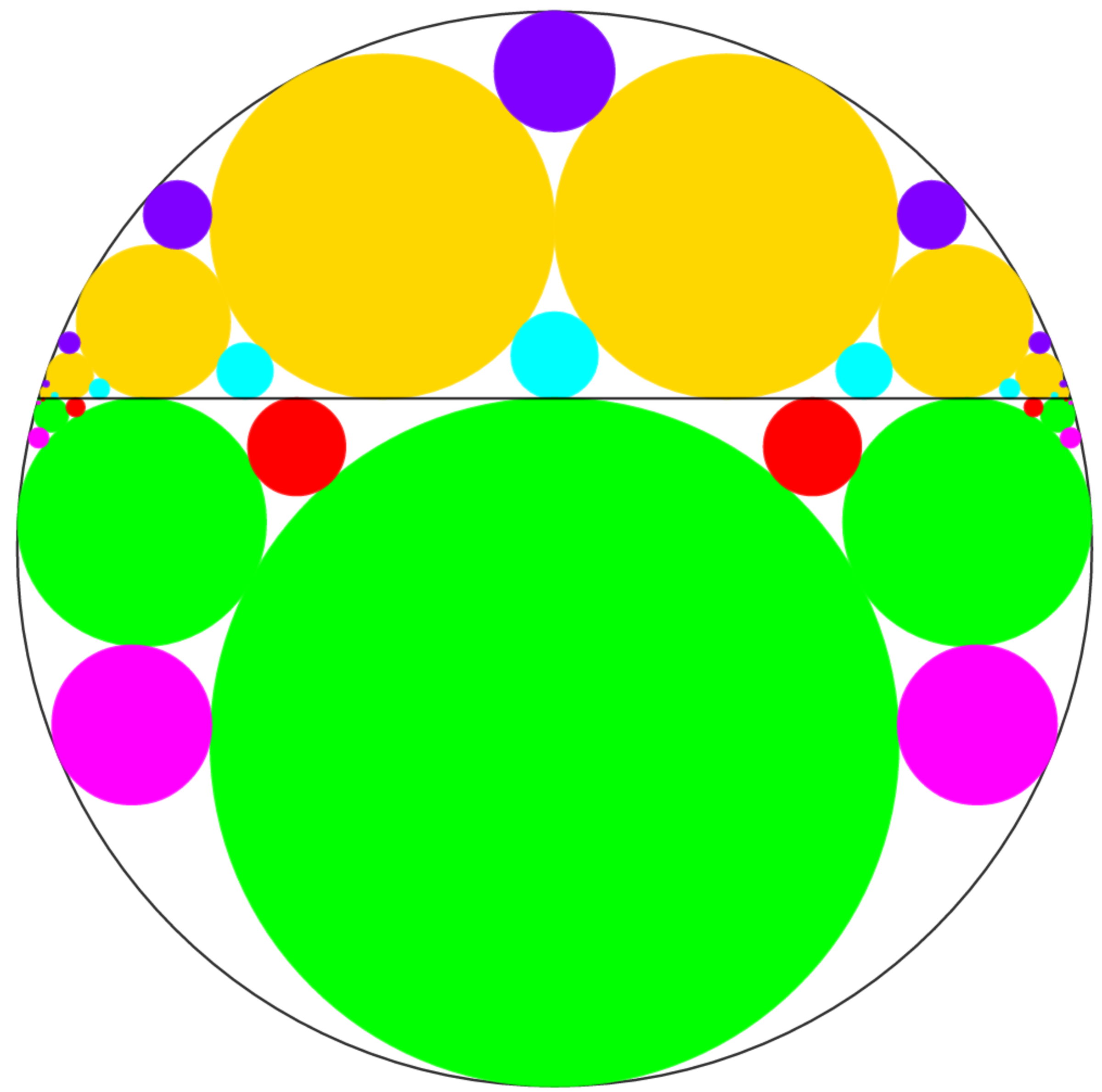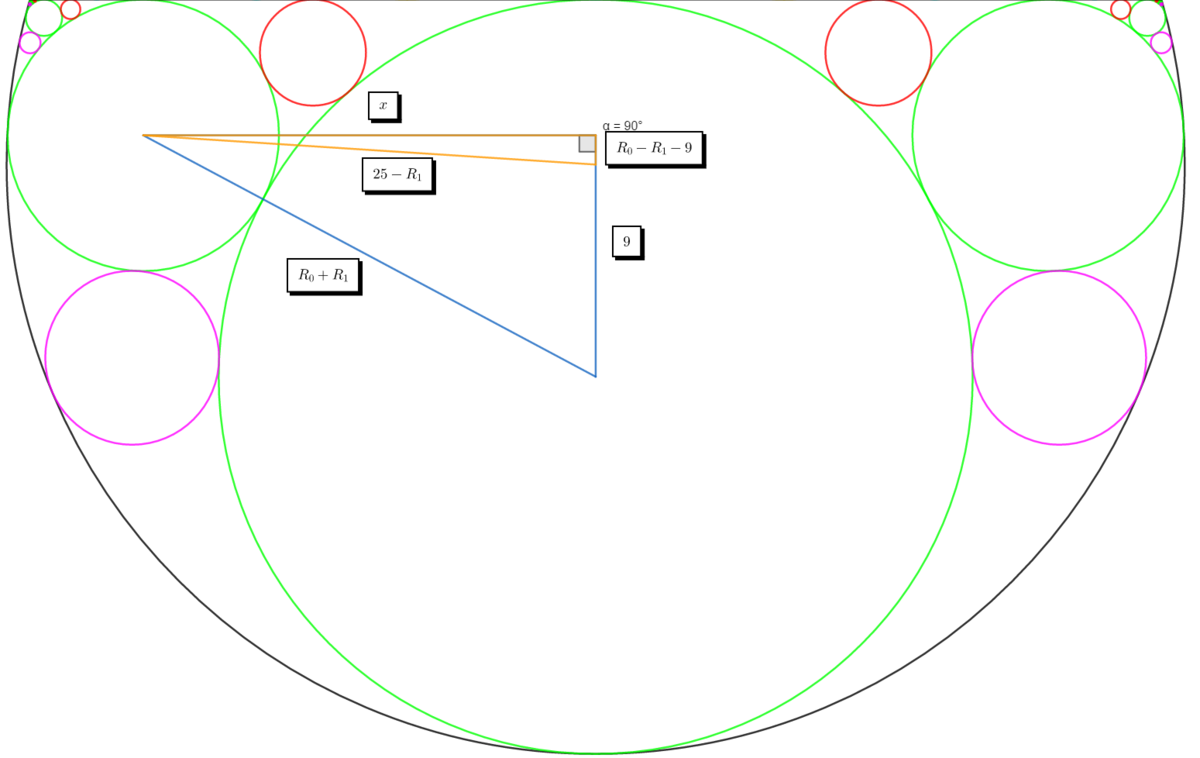Descartes Sangaku : The End part 1
- The diagram shows a black circle of radius 2 5 .
- We drawn an horizontal black line to divide this circle into two circular segments. This line a length 4 8 .
- Now we pack the top circulair segment with 3 types of circles : Y e l l o w , C y a n and P u r p l e .
- Then we pack the bottom circular segment with 3 types of circles : G r e e n , R e d and P i n k
- Note : The two biggest yellow circles are congruent.
- The bottom circular segment is larger than the top circular segment
- We count the circles starting from the largest of its sequence to the right (or left) towards the infinitely small circles
- We focus on the Y e l l o w and G r e e n circles in this problem. The largest G r e e n circle is the 0 t h circle of its sequence. The largest Y e l l o w circle is the 0 t h circle of its sequence.
The question: The radius of the n t h Y e l l o w circle (for n ≥ 0 ) can be expressed as ( b b ⋅ n + a + a ) b ( a + b ) b ⋅ b ( b ⋅ n + a + b ) and the radius of the n t h G r e e n circle (for n ≥ 0 ) can be expressed as ( d ( n ⋅ c ) + c − d ) c c d ⋅ d ( n ⋅ c ) where a , b , c , d are positive integers. Calculate a + b + c + d

The answer is 10.
This section requires Javascript.
You are seeing this because something didn't load right. We suggest you, (a) try
refreshing the page, (b) enabling javascript if it is disabled on your browser and,
finally, (c)
loading the
non-javascript version of this page
. We're sorry about the hassle.
1 solution
- First we need to know the heights of both circular segments. We use the product of chords theorem in a circle :
- ( 2 4 8 ) 2 = h 1 ⋅ h 2 < = > h 1 = 1 8 and h 2 = 3 2 since h 1 = 5 0 − h 2
- Then the largest green circle has radius 2 3 2 = 1 6
-
To calculate the radii of consecutive green circles we use the pythagorean theorem:

- We use those two right triangles to write two equations: { ( R 0 + R 1 ) 2 = ( R 0 − R 1 ) 2 + x 2 ( 2 5 − R 1 ) 2 = ( R 0 − R 1 − 9 ) 2 + x 2
- R 0 = 1 6 and 9 is the distance bewteen the center of the largest circle containing all the others and the center of the green circle.
- After solving the system of equations we find R 1 = 2 5 1 4 4
- We can repeat this process to find the first 5 terms of the sequence:
- R 0 = 1 1 6
- R 1 = 2 5 1 4 4
- R 2 = 1 6 8 1 1 2 9 6
- R 3 = 1 3 3 2 2 5 1 1 6 6 4
- R 4 = 1 0 7 6 4 9 6 1 1 0 4 9 7 6
- Let's look at the numerator. It's difficult to identify a pattern, but with some effort and research, we can rewrite them :
- 1 6 = ( 4 ) 2 = ( 4 ⋅ 3 0 ) 2
- 1 4 4 = ( 1 2 ) 2 = ( 4 ⋅ 3 1 ) 2
- 1 2 9 6 = ( 3 6 ) 2 = ( 4 ⋅ 3 2 ) 2
- 1 1 6 6 4 = ( 1 0 8 ) 2 = ( 4 ⋅ 3 3 ) 2
- 1 0 4 9 7 6 = ( 3 2 4 ) 2 = ( 4 ⋅ 3 4 ) 2
- The numerator can be written as ( 4 ⋅ 3 n ) 2
- Let's look at the denominator. It's difficult to identify a pattern, but with some effort and research, we can rewrite them :
- 1 = 4 4 = 4 2 2 = 4 ( 3 2 ⋅ 0 + 1 ) 2
- 2 5 = 4 1 0 0 = 4 1 0 2 = 4 ( 3 2 ⋅ 1 + 1 ) 2
- 1 6 8 1 = 4 6 7 2 4 = 4 8 2 2 = 4 ( 3 2 ⋅ 2 + 1 ) 2
- 1 3 3 2 2 5 = 4 5 3 2 9 0 0 = 4 7 3 0 2 = 4 ( 3 2 ⋅ 3 + 1 ) 2
- 1 0 7 6 4 9 6 1 = 4 4 3 0 5 9 8 4 4 = 4 6 5 6 2 2 = 4 ( 3 2 ⋅ 4 + 1 ) 2
- The denominator can be written as 4 ( 3 2 ⋅ n + 1 ) 2
- Then R n = ( 3 2 ⋅ n + 1 ) 2 6 4 ⋅ 3 2 ⋅ n = ( 3 n ⋅ 4 + 4 − 3 ) 4 4 3 ⋅ 3 n ⋅ 4
- Then c = 4 and d = 3
- We can use a similar method to get the radii of the yellow circles, the consecutive Pythagorean equations give the sequence:
- R 0 = 1 8
- R 1 = 9 3 2
- R 2 = 1 2 1 1 2 8
- R 3 = 1 8 4 9 5 1 2
- R 4 = 2 9 2 4 1 2 0 4 8
- Let's look at the numerator. We can rewrite them :
- 8 = 2 2 ⋅ 0 + 3
- 3 2 = 2 2 ⋅ 1 + 3
- 1 2 8 = 2 2 ⋅ 2 + 3
- 5 1 2 = 2 2 ⋅ 3 + 3
- 2 0 4 8 = 2 2 ⋅ 4 + 3
- The numerator can be written as 2 2 ⋅ n + 3
- Let's look at the denominator. It's difficult to identify a pattern, but with some effort and research, we can rewrite them :
- 1 = 1 2 = ( 3 3 ) 2 = ( 3 2 2 ⋅ 0 + 1 + 1 ) 2
- 9 = 3 2 = ( 3 9 ) 2 = ( 3 2 2 ⋅ 1 + 1 + 1 ) 2
- 1 2 1 = 1 1 2 = ( 3 3 3 ) 2 = ( 3 2 2 ⋅ 2 + 1 + 1 ) 2
- 1 8 4 9 = 4 3 2 = ( 3 1 2 9 ) 2 = ( 3 2 2 ⋅ 3 + 1 + 1 ) 2
- 2 9 2 4 1 = 1 7 1 2 = ( 3 5 1 3 ) 2 = ( 3 2 2 ⋅ 4 + 1 + 1 ) 2
- We can then write the denominator as ( 3 2 2 n + 1 + 1 ) 2
- Then R n = ( 2 2 n + 1 + 1 ) 2 9 ⋅ 2 2 n + 3 = ( 2 2 n + 1 + 1 ) 2 ( 1 + 2 ) 2 ⋅ 2 2 n + 1 + 2
- Then a = 1 and b = 2
- Finally a + b + c + d = 1 + 2 + 3 + 4 = 1 0